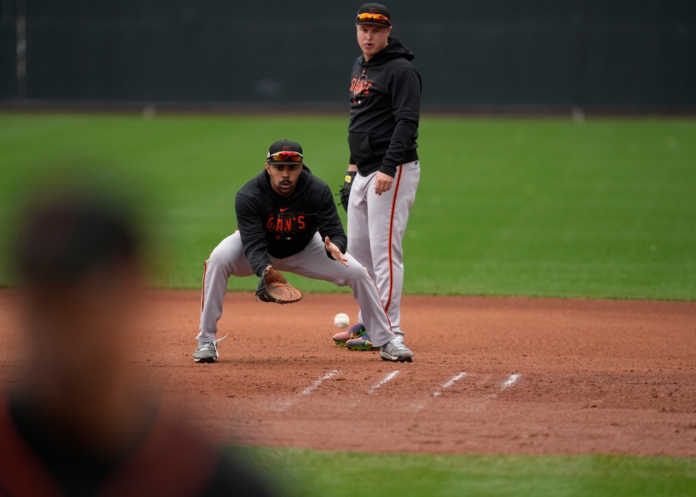SCOTTSDALE, Ariz. — A manager’s time is valuable in spring training. He can only be in one place at a time, when his players are divided into a dozen or more groups spread across multiple fields. What he chooses to observe shows his priorities.
Gabe Kapler is watching the Giants’ defensive fundamentals.
“I just feel like we were not great at executing the fundamentals last year,” Kapler said.
The eye test spoke for itself.
So do the numbers: By Defensive Runs Saved (minus-53), they were dead last. By Outs Above Average (minus-32), they were third-worst. They committed 100 errors, tied for the fourth-most in the majors.
It stood in stark contrast to the previous season, when they were among the upper third of the league in each metric.
So, that is why Kapler begins each morning standing on the infield of the diamond here at Scottsdale Stadium, watching his pitchers go through fielding practice, his infielders chase down runners and his outfielders hit the cutoff man.
But that’s not all.
“We’re framing it a little bit differently,” Kapler said. “We want our players to know how often things occur. Like, how often are we getting over to first base to cover? How often are we fielding a comebacker? How often are we fielding a bunt? And then going back and talking about how successful we were at those tasks relative to the league in the last couple of years. These are areas that we can definitely improve if we talk about why we weren’t a playoff team last year.”
That is why when you walk into the home clubhouse here, on the big-screen monitors above the lockers, there is a carousel of rotating video clips. They highlight good examples of different fundamentals — bunt defense, rundowns, outfield cutoffs — and, yes, there were enough examples from last season to fill at least a 30-second reel (though one clip does feature outfielder Luis González moonlighting on the mound).
The real message, though, scrolls before the start of the highlight package.
Picture the Star Wars intro text.
Because that’s exactly what it is.
Only these words don’t mention anything about a galaxy far, far away. They provide the framing that Kapler is talking about.
“For me,” said bench coach Kai Correa, the mastermind behind the idea, whose primary responsibilities include infield defense, “at the start of a Star Wars movie, that running theme, that text, what it does is provide context.
“What you seek when you’re a player is, ‘Hey, my time and my workload is really valuable and this job is really, really hard. So if I have context to an activity that might not be my most favorite thing in the world to do, it helps for me to then understand why I’m going to spend my time doing that.’ So my thought process by adding was that it was just a fun way, an attention-getting way to provide that context.”
For example, on rundowns:
“We got a runner out via the rundown 17 times. A little more than once every 10 games. Often enough that we have to establish roles in spring but not often enough that we will have to revisit it often.”
And sacrifice bunts:
“In 2022, teams attempted 30 sacrifice bunts against us, which is almost one in every five games. 17 of those bunts came late in games, after the seventh inning. Our record was 7-23 in those games.”
Before becoming Kapler’s bench coach, Correa gained recognition for his videos teaching fielding techniques. He still runs camps during the offseason. It’s a passion for him. And their success in 2021 seemed to be a positive test case.
But then 2022 happened.
“It didn’t sit well with us,” Correa said.
There are a couple reasons why, he believes, this year will be different.
“We were playing games where the people who were executing fundamentals weren’t even in major-league camp,” he said. “You think about a large quantity of position players that played with us, they were in camp with other teams or minor-league camp.”
There was also the effect of a shortened spring training from the lockout. Time once spent teaching was gone. While every team faced the same reality, the Giants, Correa believes, were particularly affected because of their trouble staying healthy, which led to a franchise-record 66 players passing through the clubhouse — 20 who began the season in other organizations.
“Finally without COVID protocols, without the lockout, we can go back to spending the time to get into the weeds on those things, answer questions and have good dialogues,” Correa said. “Now that that’s not a concern, you can go back into teaching mode.”
Back on the Scottsdale Stadium infield grass, Kapler and Correa gathered the couple dozen position players going through drills Thursday morning and provided feedback. When they were done, another voice spoke up. It was Brandon Crawford, who will be the first to tell you he’s not the speech-giving type.
Working with the pitchers, Correa said, it’s fellow veterans Alex Wood, Alex Cobb and Luke Jackson, as well as staff ace Logan Webb, who are speaking up — either with feedback for the group or their own clarifying questions.
Webb and Crawford have separately said the team got “complacent” at times last season, one cause of their cascading defensive issues.
This spring, they’re trying to set a different tone.
“Those things echo internally. They have big ripples,” Correa said. “It was the same thing with Buster (Posey) prior to 2021. When he was invested like he was prior to 2021, it was hard not to be. Now we’re seeing that same thing repeated: These veteran players are asking the questions, they’re driving the process.”


